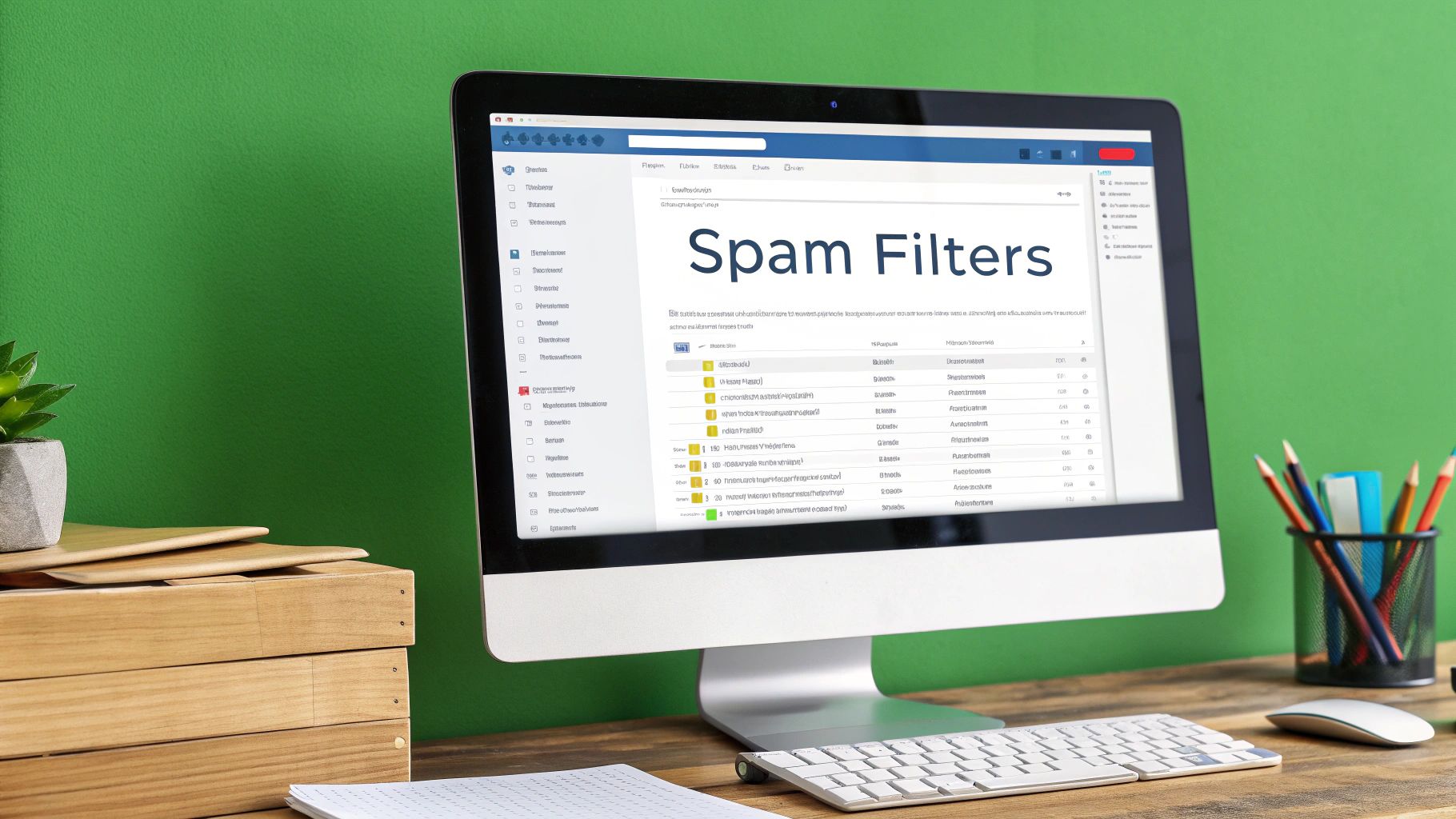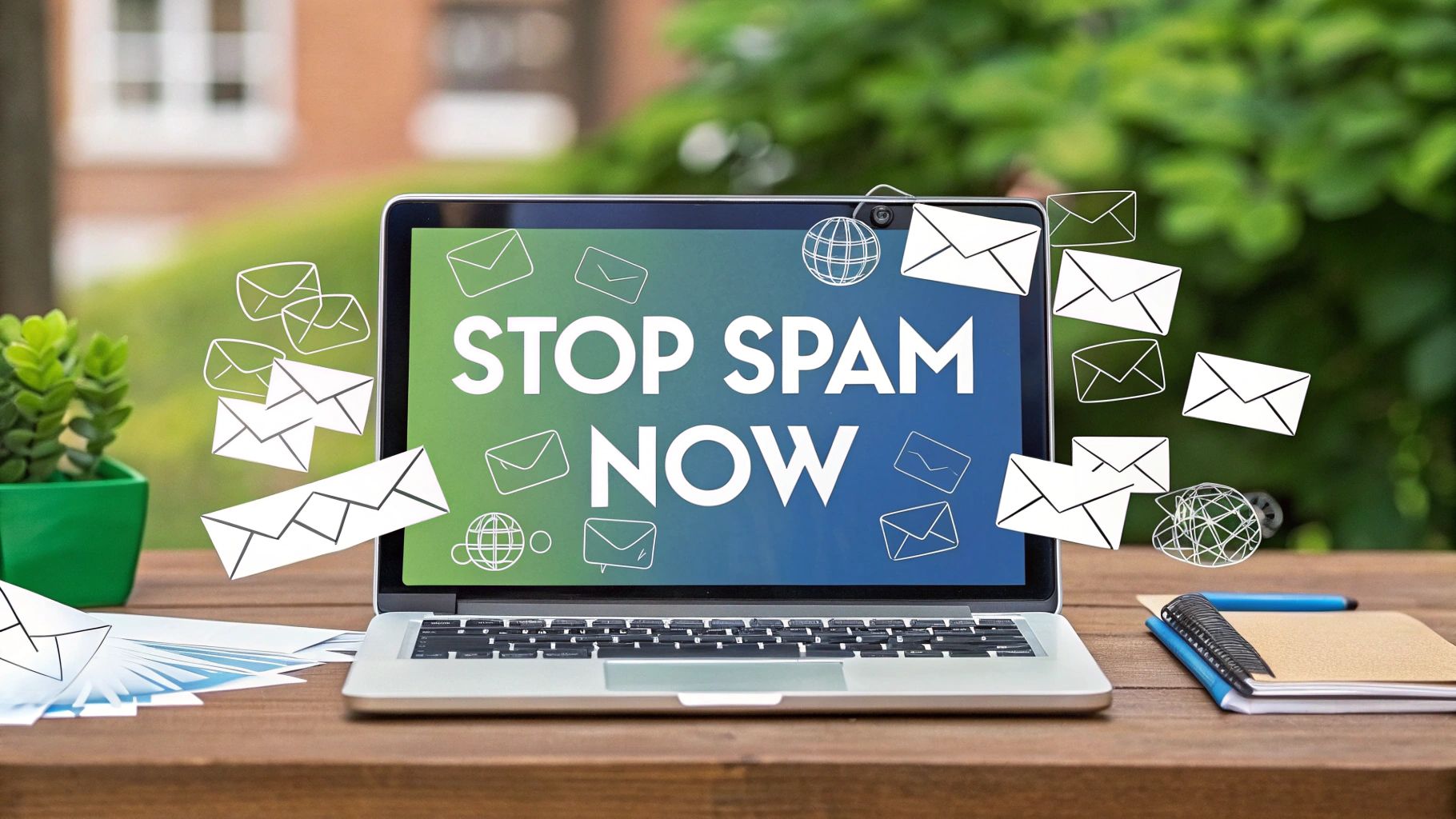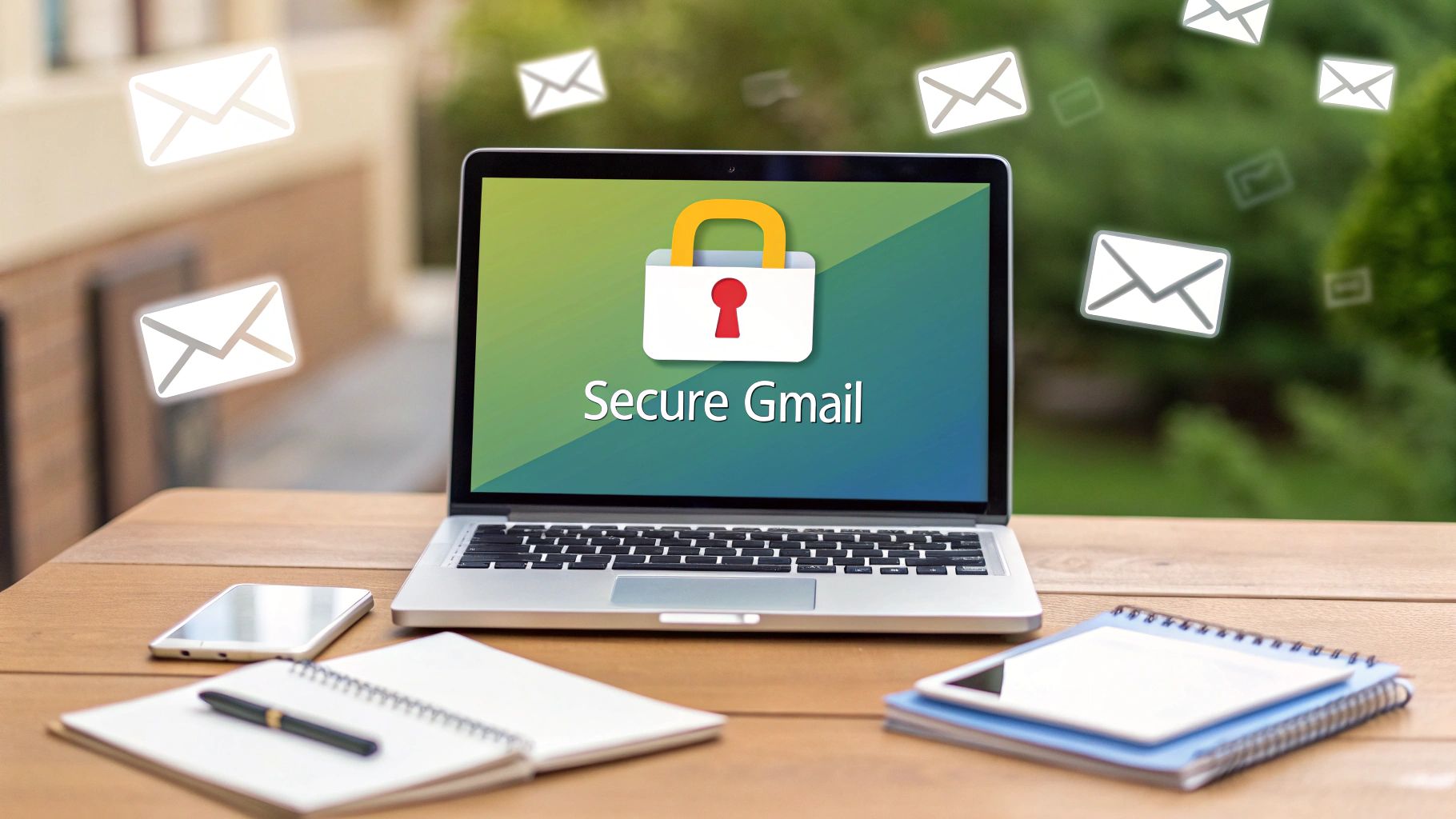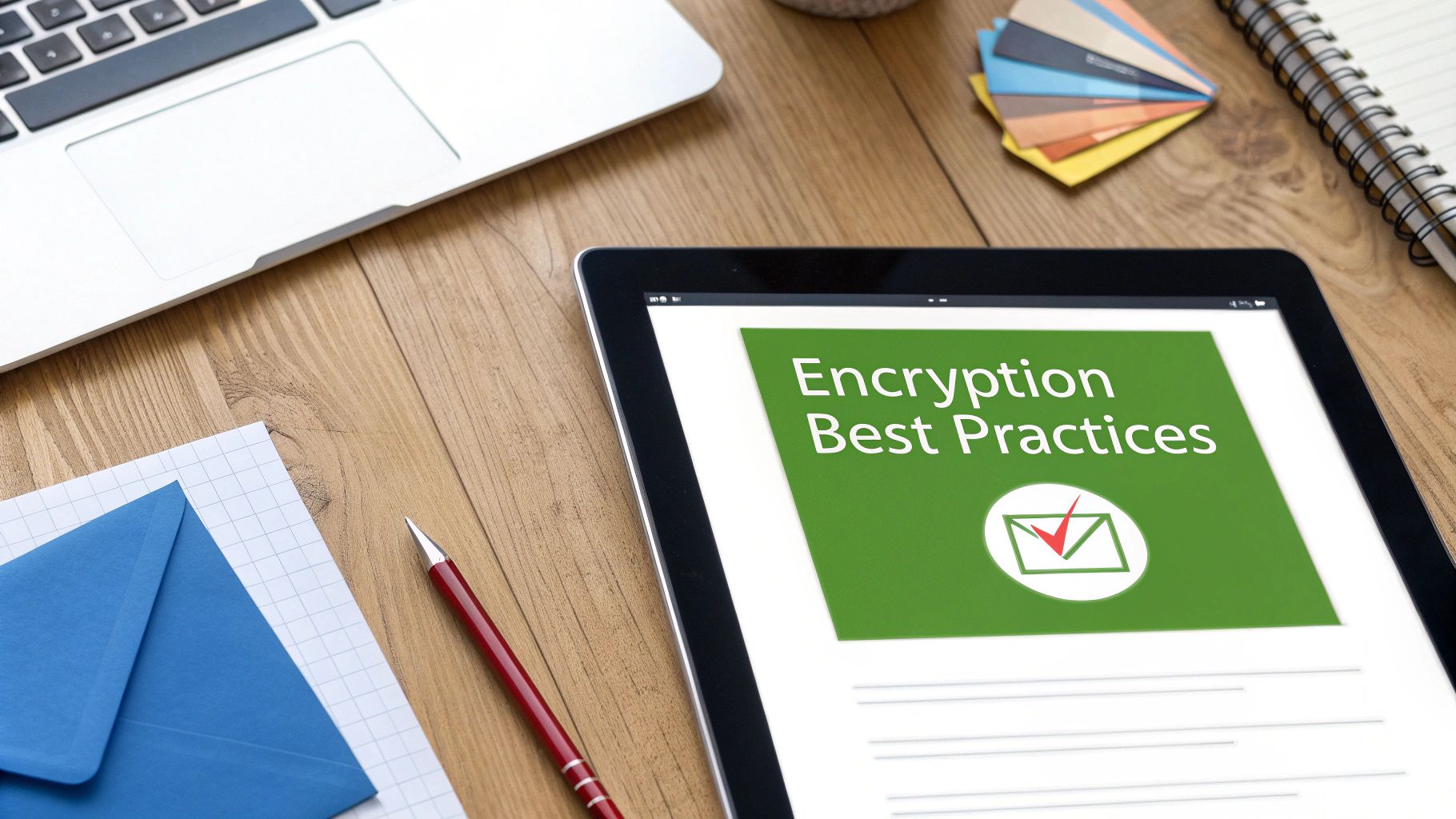To truly stop spam, you need to think in layers. It's about combining the tools your email provider already gives you, like spam filters, with smarter email security habits, like using aliases for new sign-ups. For those who want the ultimate defense, moving to a secure, hosted email platform is the final piece of the email privacy puzzle. This mix of reactive tools and proactive strategies is how you take back control of your inbox for good.
Why Your Inbox Is Such a Prime Target
Think of your email address as a digital front door. It’s a direct line to you, which makes it an incredibly valuable commodity for everyone from aggressive marketers to outright criminals. Every time you subscribe to a newsletter, create an online account, or leave your email on a public forum, you're essentially handing out keys to that door. For spammers, your inbox represents a low-cost, high-reward playground, putting both your email privacy and security at risk.
This isn't just a minor annoyance; the scale of the problem is massive. By 2025, spam is expected to account for a staggering 45% of all daily email traffic worldwide. That boils down to an estimated 14.5 billion spam messages flooding the internet every single day. For the average person, that could mean sorting through over 1,800 unwanted emails a year. No wonder keeping a clean inbox feels like a full-time job. You can dig deeper into these email spam statistics and their impact to see the full picture.
How Did They Get My Email Anyway?
Spammers are resourceful, and they have several well-worn methods for getting their hands on your email address, often without you even realizing it. Knowing how your email gets out there is the first step to improving your email security.
- Data Breaches: This is the big one. A company you've trusted with your information gets hacked, and suddenly your email, passwords, and other personal details are for sale on the dark web.
- Public Postings: Ever listed your email on a personal blog, a social media bio, or a forum? Automated bots, called scrapers, constantly crawl the web looking for exactly that. They harvest these addresses and add them to massive spam lists.
- Shady Sign-Up Forms: Some websites, especially "free" services, compromise your email privacy by selling your data to marketing companies. Your email address is the price of admission.
- Brute-Force Guessing: It can be as simple as spammers using software to generate millions of common email combinations (think
jane.doe@domain.comorsales@company.com) and firing away.
The Many Faces of Spam
Not all spam is the same. Some of it is just annoying clutter from a pushy company, but other types can be genuinely dangerous, putting your personal information and financial security at risk.
Before we dive into the solutions, it's helpful to know what you're up against. Here’s a quick rundown of the most common spam types and the real dangers they pose to your email security.
Common Spam Types and Their Hidden Dangers
| Spam Type | Primary Goal | Key Risk |
|---|---|---|
| Phishing | Steal sensitive information | Identity theft, financial loss, account takeover |
| Malware/Viruses | Infect your device | Data theft, ransomware, device damage |
| Scams & Hoaxes | Deceive you into sending money | Direct financial loss |
| Unsolicited Ads | Sell you a product or service | Annoyance, potential links to malicious sites |
| Spoofing | Impersonate a trusted contact | Tricking you into sharing information or funds |
Recognizing these different threats is crucial. An aggressive marketing email is just a nuisance you can block and delete. But a phishing email disguised as a notice from your bank is a serious security threat that demands a different response.
The most dangerous spam doesn't just want to sell you something—it wants to trick you. Phishing attacks are expertly designed to look like they're from your bank, a delivery service, or another trusted company, all in an effort to steal your logins and financial details.
Once you can spot the difference between junk and a genuine threat, you're in a much better position to build an effective defense and keep your inbox safe.
Your Email Provider's Built-In Tools Are Your First Line of Defense

Before you even think about third-party apps, take a look at the powerful tools you already have. Hosted email platforms like Gmail and Outlook spend a fortune on smart, AI-powered systems to catch junk mail. Your job is to give those systems a helping hand to enhance your email security.
Just deleting a spam email doesn't accomplish much. The single most important thing you can do is smash that "Mark as Spam" or "Report Junk" button. This does way more than just hide the message; it sends a powerful signal back to your provider. Every time you report something, you're training their algorithm to get better at spotting similar security threats in the future—not just for you, but for everyone.
Get Proactive With Filters and Rules
Marking spam is great for cleaning up what’s already arrived, but filters and rules let you take control before the mess even happens. Think of them as your personal bouncers for your inbox, deciding who gets in and where they go. This is a core part of maintaining your email security.
You can set up rules that automatically manage your mail based on almost any criteria you can think of.
Here are a few practical ideas to get you started:
- Block by Sender: If a specific address just won't quit, create a rule to send everything from them straight to the trash.
- Filter by Keywords: Sick of seeing "Limited Time Offer" or "You've Been Selected"? Set up a filter that looks for those phrases in the subject line and automatically deletes them or moves them to a folder you can check later.
- Block an Entire Domain: Can't get off a company's mailing list no matter how many times you unsubscribe? Block their entire domain (like
@annoyingcompany.com) to stop them for good.
A few well-crafted filters can seriously cut down on your daily inbox cleanup, often by up to 80%. It might take a few minutes to set them up, but you'll save yourself hours of manual sorting and frustration down the line.
Fine-Tuning Your Spam Defenses
The goal here is to build a defense that adapts as spammers change their tactics. Most people never dive into their email settings, but there's a ton of control hiding in there. If you want a deeper dive, you can learn more about how spam filtering protects your email security and privacy.
The real magic happens when you combine your provider's smart technology with your own common sense.
Build These Inbox Habits:
- Check Your Spam Folder (Occasionally): Once a week, take a quick 30-second scan of your spam folder. You're looking for "false positives"—legitimate emails that got caught by mistake. Rescuing them helps train the filter to be more accurate.
- Make an "Unsubscribe" Filter: Instead of dealing with every newsletter, create a rule that finds the word "unsubscribe" in the email body. Have it automatically archive these messages or stash them in a "Promotions" folder to read later.
- Use the Block Button: The "Block Sender" feature is your best friend for repeat offenders. Don't be shy about using it.
By actively using these tools, you stop being a passive target for spam and become the active guardian of your own inbox.
Go on the Offensive for Ultimate Email Privacy

When the usual filters and blocklists just can't keep up, it's time to change the game entirely. The best defense is a good offense, and in the war against spam, that means making your primary email address a closely guarded secret.
Think about it: the single most effective way to stop receiving spam is to prevent your real address from getting into the wrong hands in the first place. This requires a shift in mindset—from reacting to junk mail to proactively building a wall of email privacy between your inbox and the outside world. This is where tools like email aliases and disposable addresses become your secret weapon.
Create Aliases for Every Service
An email alias is simply a forwarding address. It looks and acts like a real email, but any message sent to it is quietly routed to your main inbox. I like to think of them as unique keys for every service I sign up for—they all open the same door, but I know exactly which key was used.
For instance, if I'm signing up for a new social media site, I won't use my real email. Instead, I'll create something like socialnetwork.2024@mydomain.com. If that specific address ever starts getting flooded with junk, I know exactly which company either sold my data or had a security breach.
The real power here is the control it gives you. You can just delete the compromised alias, instantly cutting off the spam source without touching your main account or disrupting any other services. It's surgical.
Adopting this strategy is a massive leap forward for your email privacy. By giving each service its own unique address, you effectively quarantine any potential data leaks. Spammers might get an address from a hacked database, but it’s a dead-end one they can't use elsewhere. To get a deeper dive, check out the ultimate guide to an email alias service to see how you can set this up.
Use the "Plus Addressing" Trick
If you don't use a dedicated alias service, there's a clever built-in feature in many hosted email platforms like Gmail and Outlook called plus addressing. It lets you generate unique, trackable variations of your email address instantly, right on the spot.
It's incredibly simple. You just add a + sign and any word after your username but before the @ symbol.
- Signing up for a store's loyalty card? Use
yourname+thestore@email.com. - Subscribing to a newsletter? Try
yourname+techreads@email.com. - Downloading a one-time file? Make it
yourname+whitepaper@email.com.
All mail sent to these addresses will still land in your primary inbox. The magic is that you can see exactly which address it was sent to. This makes it dead simple to create a filter that automatically archives, labels, or deletes messages sent to yourname+thestore@email.com, especially if they start sending you unrelated junk. You've caught the source red-handed.
Bring in the Privacy Specialists
For the highest level of control and anonymity, dedicated services like SimpleLogin or AnonAddy are the way to go. These platforms are built specifically for this purpose, letting you generate unlimited random, anonymous aliases that forward to your real email.
Here's why they are so powerful:
- Complete Anonymity: Your real email address is never exposed to any website or service.
- One-Click Kill Switch: An alias getting spammed? Just flip a switch and it's gone. No more emails from that source.
- Reply in Disguise: You can even reply to forwarded emails, and the service sends it through the alias, keeping your true address hidden.
When you start using these advanced tactics, you're no longer just playing defense. You stop being a janitor for your inbox and become the architect of a fortress that keeps spam from ever reaching your door.
Upgrade to a Secure Hosted Email Platform
If you're truly fed up with the endless tide of junk mail, the most powerful move you can make is to switch to a secure, privacy-first hosted email platform. It’s a game-changer for your email security and privacy.
Free email services are convenient, but there's a trade-off. Their business often revolves around collecting data for advertising purposes. A secure email host, on the other hand, operates on a totally different principle: you're the customer, not the product they're selling to advertisers.
This isn't just a philosophical difference—it directly impacts your inbox security. Providers like ProtonMail and Tutanota are built from the ground up for privacy. They have zero incentive to scan your emails for ad-targeting keywords, which means their systems are entirely focused on identifying and blocking security threats. The result is just plain better spam filtering.
Why Secure Platforms Are So Good at Blocking Spam
The magic is in their architecture. Many of these services use what’s called a zero-access architecture, a fancy term that means even the provider can't read your emails. They are physically incapable of decrypting them. This creates a powerful shield against sophisticated spam that tries to sneak past filters by analyzing your email content.
They also rely heavily on end-to-end encryption, scrambling your messages from the moment you hit "send" until your recipient opens them. While that's mainly a privacy feature, it builds a much more secure environment overall. Spammers thrive on exploiting the weaknesses of huge, mass-market platforms, so a hardened ecosystem is naturally less appealing to them.
If you're curious about which service might be right for you, we have a detailed breakdown of the top 7 best email providers for privacy in 2025 that’s worth a look.
When you choose a platform that makes privacy the default setting, you're getting more than just tools. You're joining an entire ecosystem designed to be hostile to spammers and data miners right from the start.
This visual shows just how much more effective automated filtering—a core strength of secure platforms—is compared to sorting junk mail by hand.

As you can see, letting a robust system do the work isn't just more accurate; it frees up a surprising amount of your time every single week.
The table below breaks down the key differences you can expect.
Comparing Standard vs Secure Email Providers
While free services are a great starting point, a secure, paid provider offers a fundamentally different level of protection and privacy.
| Feature | Standard Providers (e.g., Gmail) | Secure Providers (e.g., ProtonMail) |
|---|---|---|
| Primary Business Model | Ad-supported, based on user data analysis | Subscription-based, focused on user privacy and security |
| Spam Filtering Focus | General-purpose, balances filtering with ad-related data needs | Aggressive and security-focused, no conflicting ad business interests |
| Encryption | Encrypts data in transit, but provider can access emails | End-to-end encryption and zero-access architecture by default |
| Data Privacy | Emails are often scanned to personalize ads and other services | Your emails are never scanned or shared with third parties for marketing |
| Account Security | Standard 2FA and security options | Advanced features like hardware key support and anonymous signup options |
| Cost | Free (with data as the "payment") | Paid subscription (typically a few dollars per month) |
Ultimately, the choice comes down to what you value most. A secure provider is an investment in a more private and less cluttered digital life.
Making the Switch for Good
I get it—moving to a new email address can feel like a major project. But think of it as the final, decisive step toward permanently stopping junk mail. These hosted email services are built for people who are serious about reclaiming their privacy and finally getting a quiet inbox.
Here’s what you get when you upgrade:
- Best-in-Class Spam Filtering: Their algorithms are purely focused on security, so they catch the nasty, sophisticated junk that slips through other filters.
- An End to Data Mining: Your personal conversations stay personal. No scanning, no selling to advertisers.
- A Fortress of Security: Features like end-to-end encryption protect you from far more than just annoying spam.
Free services offer a fence. A dedicated secure email host gives you a fortress. It's a small investment for a much cleaner, safer, and more private online experience.
Adopting Habits That Keep Your Inbox Clean

Even the most sophisticated email security platform can't save an email address that’s shared carelessly across the web. While technology gives us a powerful shield, it's our daily online habits that truly harden our defenses against the constant onslaught of spam. Think of it as the final, crucial layer in your strategy to reclaim your inbox.
The single most important habit to learn is this: never click "unsubscribe" on an email you already know is spam. Legitimate companies are required to honor those requests, but spammers see that link as a golden opportunity. Clicking it simply confirms your email address is active and that a real person is on the other end, which often invites even more junk mail.
Cultivating Mindful Online Behavior
Protecting your primary email address starts with being more deliberate and skeptical about where you share it. Before you type it into any sign-up form, take a moment to consider your email privacy.
A classic trick you'll see everywhere is the pre-checked marketing box. When you're creating a new account or making a purchase, hunt for those little boxes that automatically opt you into newsletters and promotional materials. Making a habit of unchecking them every single time is a small effort that prevents a massive amount of future clutter.
Phishing, a particularly nasty type of spam, is a global menace. An estimated 3.4 billion phishing emails are sent every single day. For businesses, the fallout from a successful attack is immense, costing an average of $4.88 million per data breach. Being hyper-vigilant about what you click is your best defense. You can dig into the latest phishing statistics and trends to really grasp the scale of the problem.
Strengthening Your Account Security
Your email account is the master key to your digital life. It’s tied to your banking, social media, and countless other services. Protecting it isn't just about stopping annoying spam—it's about securing your entire online identity. This is where basic security hygiene becomes absolutely non-negotiable.
Here are a couple of essential practices you should implement right now:
-
Use Strong, Unique Passwords: Reusing passwords is one of the biggest security mistakes you can make. Get a good password manager to create and store long, complex, and unique passwords for every single account you own. That way, if one site gets breached, your email remains locked down.
-
Enable Two-Factor Authentication (2FA): This is arguably the most effective security measure you can take. 2FA adds a second verification step, like a code sent to your phone, before granting access. It’s a simple move that effectively slams the door on anyone who has managed to steal your password.
Adopting these habits does more than just filter out noise. It transforms your inbox from an easy target into a fortified space, making it dramatically harder for spammers and cybercriminals to get through.
Answering Your Top Questions About Stopping Spam
Even after setting up the best defenses, you'll still have questions pop up. It's just the nature of the beast. Let's tackle some of the most common ones I hear, so you can handle those tricky situations with confidence.
Should I Click Unsubscribe on Spam Emails?
This is the million-dollar question, and the answer is… it depends. If the email is from a legitimate business you know—like a retailer you bought something from or a newsletter you actually remember subscribing to—then yes, the unsubscribe link is your friend. They are legally required to honor it.
But for anything that looks even remotely like junk, a phishing attempt, or just a sender you've never heard of? Do not click "unsubscribe." Hitting that link often does the opposite of what you want. It's like raising your hand in a crowd of spammers and shouting, "Hey, this email address is active!" This just confirms your address is real, making it more valuable to them and other data brokers.
My rule of thumb is simple: If you don't recognize it, don't risk it. Just mark it as spam and let your email provider take it from there.
Why Am I Suddenly Getting So Much Spam?
It's unsettling when your inbox goes from a gentle stream to a raging flood of junk overnight. This usually happens for a few key reasons. Most of the time, your email was probably scooped up in a recent data breach from a service you use, compromising your email security.
Another common culprit is signing up for a new app or website that quietly sells your data to marketing partners. And sometimes, it's just bad luck—your email might have been scraped from a public website by a bot or even just guessed by a spammer's algorithm. A quick check on a site like Have I Been Pwned can often tell you if you've been part of a known breach.
Can I Report Spam to Make a Difference?
Yes, you can, and you absolutely should. The single most powerful thing you can do is hit that "Mark as Spam" or "Report Junk" button in your email app. This isn't just about cleaning up your own inbox. It sends valuable intel back to your email provider, helping them train their filters to catch similar junk for everyone. You’re contributing to better email security for all users of that platform.
For the really nasty stuff, like phishing scams trying to steal your info, you can go a step further. Forwarding the email to dedicated anti-cybercrime groups helps them track and shut down these operations. In the U.S., you can forward them to the Anti-Phishing Working Group at reportphishing@apwg.org or the FTC at spam@uce.gov.
Is It Possible to Get Rid of Spam Forever?
I'd love to say yes, but the honest answer is no. Getting rid of 100% of spam forever is pretty much impossible. Spammers are relentless and are always inventing new ways to slip past the defenses we put up.
The realistic goal isn't a completely sterile inbox, but one that is secure, manageable, and overwhelmingly clean. By using the strategies in this guide—from smart filtering and email aliases to a truly secure email provider—you can slash incoming spam by over 99%. And remember, this fight isn't just limited to email. To truly protect your focus, it's worth exploring effective ways to block unwanted phone calls as well.
Ready for an inbox that’s secure, private, and finally free from spam and ads? Typewire offers a premium email experience built on privacy from the ground up. With advanced anti-spam protection, no tracking, and zero data mining, you can take back control of your communications. Explore our secure email hosting and start your 7-day free trial today at https://typewire.com.






